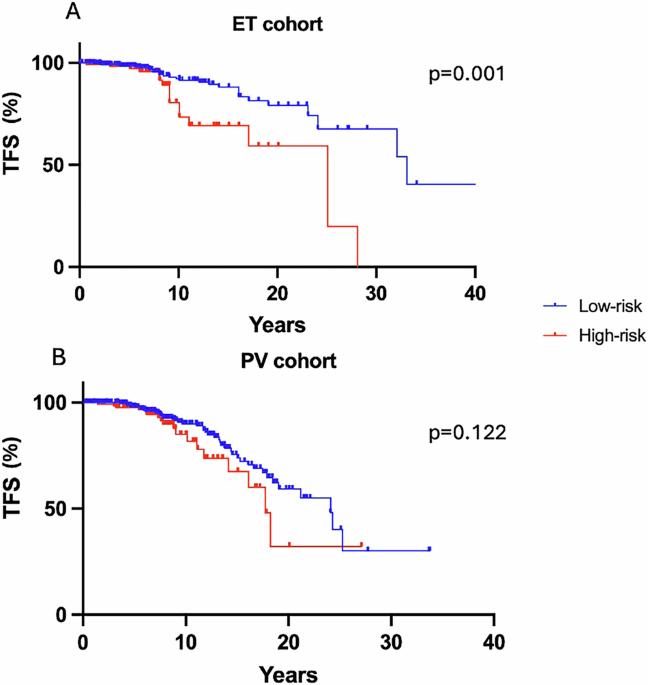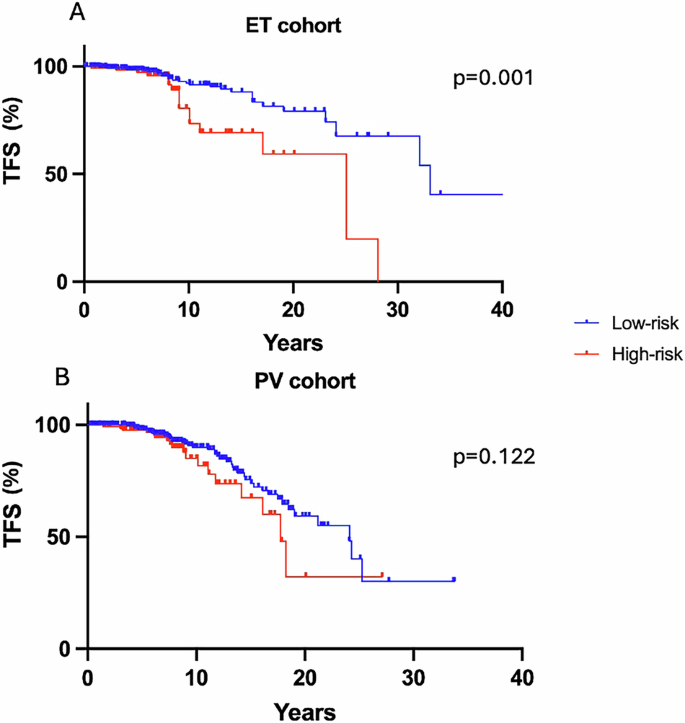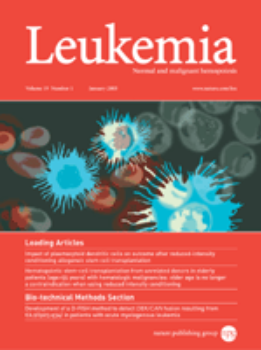QRISK3评分可预测骨髓增殖性肿瘤患者的血栓形成风险
IF 13.4
1区 医学
Q1 HEMATOLOGY
引用次数: 0
摘要
血栓栓塞事件(TE)是真性红细胞增多症(PV)和原发性血小板增多症(ET)中最常见的发病和死亡原因。QRISK3模型是一种预测普通人群TE的工具,7.5%被认为是识别高危患者的阈值。我们分析了937例患者(490例ET和447例PV)的数据,中位随访时间为85个月和95个月,分别报告了52例和73例TE。在两个队列中,常规高危患者诊断时的中位QRISK3评分较高(ET;高危组为4.2,低危组为2.4;8.8 vs. 2.8, p < 0.001)。在随访期间,QRISK3评分大于7.5%,显示出进一步对TE高风险个体进行分层的潜力,在低风险和高风险患者中都优于标准风险评估。在QRISK3≥7.5%的患者中,使用细胞减少治疗而不是主动监测可以降低血栓形成的风险。在该组中,接受细胞减少治疗的ET患者中有79.7%和PV患者中有86.9%没有血栓形成,而未接受细胞减少治疗的患者中有64.1%和57.1%没有血栓形成(p = 0.018/0.034)。QRISK3识别可能需要细胞减少治疗的患者,并提供一种工具,允许患者评估、监测和降低心血管风险。本文章由计算机程序翻译,如有差异,请以英文原文为准。


QRISK3 score is predictive of thrombotic risk in patients with myeloproliferative neoplasms
Thromboembolic events (TE) represent the commonest cause of morbidity and mortality in polycythemia vera (PV) and essential thrombocythaemia (ET). The QRISK3 model is a tool for predicting TE in the general population, with 7.5% recognised as a threshold to identify high-risk patients. We analyzed data of 937 patients (490 ET and 447 PV) with a median follow-up of 85 and 95 months, reporting an occurrence of 52 and 73 TE, respectively. Median QRISK3 scores at diagnosis were higher in conventional high-risk patients in both cohorts (ET; 4.2 in high-risk vs. 2.4 in low-risk, PV; 8.8 vs. 2.8, p < 0.001). During follow-up, a QRISK3 score greater than 7.5%, demonstrated potential to further stratify individuals at high risk of TE, outperforming standard risk assessments in both low and high-risk patients. Using cytoreductive treatment instead of active surveillance in patients with QRISK3 ≥ 7.5% conferred a reduced risk of thrombosis in both cohorts. Of this group, 79.7% with ET and 86.9% with PV, on cytoreductive therapy, remained thrombosis free, compared with 64.1% and 57.1% of those not receiving cytoreductive therapy (p = 0.018/0.034). QRISK3 identifies patients in whom cytoreductive therapies may be indicated, and provides a tool that allows patients to assess, monitor and reduce their cardiovascular risk.
求助全文
通过发布文献求助,成功后即可免费获取论文全文。
去求助
来源期刊

Leukemia
医学-血液学
CiteScore
18.10
自引率
3.50%
发文量
270
审稿时长
3-6 weeks
期刊介绍:
Title: Leukemia
Journal Overview:
Publishes high-quality, peer-reviewed research
Covers all aspects of research and treatment of leukemia and allied diseases
Includes studies of normal hemopoiesis due to comparative relevance
Topics of Interest:
Oncogenes
Growth factors
Stem cells
Leukemia genomics
Cell cycle
Signal transduction
Molecular targets for therapy
And more
Content Types:
Original research articles
Reviews
Letters
Correspondence
Comments elaborating on significant advances and covering topical issues
 求助内容:
求助内容: 应助结果提醒方式:
应助结果提醒方式:


